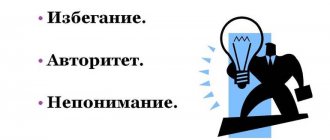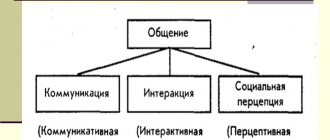Have you ever been told that you are great to talk to? Communication requires the presence of at least two people. It's an interaction anyway. And wherever you are: at home, at work, on the street, on public transport - everywhere you are surrounded by people with whom you will come into mutual contact. And communication will be effective when both you and your interlocutor receive back everything that you spent in the communication process.
For example, you spend your energy, time, strength, emotions, resources, and in return you also receive even more energy, positive emotions, even some kind of material result, help, etc. And in the same way, your interlocutor receives results from communicating with you, that is, in the end, the communication was effective for both of you.
In this article:
What is the difference between effective and ineffective communication Technologies of effective communication - what are they What is important for effective communication Ineffective communication techniques A very important rule in communication “Three Twenty” 8 powerful techniques for effective communication
What is the difference between effective and ineffective communication?
Photo by MART PRODUCTION: Pexels
If you invest your resource when communicating with someone, and get nothing in return, then this communication devastates you, it is ineffective. You probably sometimes noticed that after talking with some person, it was as if the energy had been drained from you, and after that you weren’t like that at all. Have you ever had this?
So, if you want to interact effectively with people, get the most out of communication, attract people to you, understand and feel every person, you can learn this. You will simply become a fairy sorceress who will captivate everyone who enters into dialogue with you with her attention. So, let's begin.
Psychology of communication with people and its general principles
The modern world is difficult to imagine without developed communications.
Moreover, at all levels - between individuals, diplomatic departments, business representatives and many other structures. Articles on the topic
- How to recognize a liar and manipulator during communication 10/26/2021
- Current techniques for working with the subconscious 09.20.2021
- The most important areas of education 08/28/2021
- The primary goal of raising children in modern society 05/20/2021
One of the main conditions for the psychology of communicating with people is considered to be a coincidence of interests.
During an intensive discussion of a topic that touches on the personal position of one of the participants in the conversation or the needs and benefits of others, even unsociable, withdrawn people become more talkative.
One technique is widely known, the use of which, in most cases, gives positive results. This is the Franklin effect, named after one of the US leaders. He borrowed a book from a man who didn't treat him very well. It was almost impossible to reach an understanding with him. But after that their relationship normalized and became quite friendly. The basis for the changes that took place was the belief that if a person asked for a favor and was not refused, he also would not refuse when his help was needed.
A friendly mood during a conversation can also be created by methodically repeating some of the interlocutor’s movements, his way of holding himself and some postures. If everything is done correctly and does not cause rejection, then the partner will be imbued with sympathy precisely because of the similarity in behavior. The psychology of communicating with people needs to be constantly improved.
Communication interaction can also be improved:
- addressing the interlocutor by name, since people usually do not respond to unaddressed calls;
- calling the participant in the conversation your friend, this will improve mutual goodwill and simplify dialogues;
- using reflective listening - sometimes repeating the interlocutor’s message and partially rephrasing it without changing the meaning.
During communication, you should not point out any personal defects of the interlocutor. In this way, you can easily turn a like-minded person into a hater and spiteful critic.
Effective communication technologies – what are they?
Effective communication technologies are methods, techniques and means of communication that fully ensure mutual understanding and mutual empathy between communication partners. In a word, these are simple but effective tools for mutual understanding in communication.
Empathy (sympathy) is a conscious experience of the emotional state of other people, the ability to recognize what they feel and express compassion.
There are a lot of ways, techniques and means. Millions of books have been written on the topic of communication, because communication is an entire art, and once you master it, you will become an expert in interaction.
Types of communication
Types of communication as a topic have attracted the attention of psychologists, sociologists, and historians. Antoine de Saint-Exupéry said that the greatest luxury is the luxury of human communication. Modern psychologists, since World War II, have shown considerable interest in communication methods. For example, behaviorists tended to view communication in terms of stimulus-response relationships. By the mid-1950s, much of the interest of psychologists was focused on aspects of different types of messages. Psychologists have tried to find out whether it is possible to identify something common in communication among people in general.
Depending on the means used to transmit information from one person to another, verbal and non-verbal means of interaction can be distinguished.
Finished works on a similar topic
Coursework Communication techniques in psychology 430 ₽ Essay Communication techniques in psychology 270 ₽ Examination Communication techniques in psychology 190 ₽
Receive completed work or specialist advice on your educational project Find out the cost
Verbal communication is characterized primarily by the fact that the content of the message is transmitted directly through spoken words, that is, people hear words and formulate appropriate phrases depending on what they themselves perceive by ear.
A distinctive feature of nonverbal communication is the use of auxiliary factors, such as gestures, facial expressions, touching the interlocutor during a conversation. Sometimes they can say more than words. Often, during a conversation, a person perceives not so much the words as the tone in which they were spoken. All types of communication, including non-verbal, are necessary to achieve a sense of trust and mutual understanding between people.
What is important for effective communication
To learn how to communicate effectively with people, you need to take into account the fact that almost everything matters:
- Exactly what you are saying.
- The way you talk.
- The way you can listen to your interlocutor.
- What emotions you experience.
- What emotions the interlocutor experiences.
- Whether you understand what emotions the interlocutor is experiencing.
- The way you use sign language.
Effective Communication Techniques
How to write a term paper on speech therapy
07.09.2010 243117
These guidelines are compiled to help students gain an understanding of the content and structure of coursework in speech therapy.
Logopedia of pedagogical science that studies anomalies of speech development with normal hearing, explores the manifestations, nature and mechanisms of speech disorders, develops the scientific basis for overcoming and preventing them means of special training and education.
The subject of speech therapy as a science is speech disorders and the process of training and education of persons with speech disorders.
The object of study is a person suffering from a speech disorder.
The main task of speech therapy as a science is the study, prevention and elimination of various types of speech disorders.
Coursework in speech therapy is a student's scientific and experimental research. This type of educational activity, provided for by the educational and professional program and curriculum, contributes to the acquisition of skills in working with literature, analyzing and summarizing literary sources in order to determine the range of insufficiently studied problems, determining the content and methods of experimental research, processing skills and qualitative analysis of the results obtained. The need to complete coursework in speech therapy is due to the updating of knowledge concerning the content, organization, principles, methods and techniques of speech therapy work.
As a rule, during their studies, students must write two term papers - theoretical and practical.
The first course work should be devoted to the analysis and synthesis of general and specialized literature on the chosen topic. Based on this analysis, it is necessary to justify and develop a method of ascertaining (diagnostic) experiment.
In the second course work, it is necessary to provide an analysis of the results obtained during the ascertaining experiment, as well as determine the directions and content of speech therapy work, and select adequate methods and techniques of correction.
So, let’s present the general requirements for the content and design of coursework in speech therapy.
The initial and most important stage of working on a course project is the choice of a topic, which is either proposed by the supervisor or chosen by the student independently from a list of topics that are consistent with the areas of scientific research of the department.
Each topic can be modified, considered in different aspects, but taking into account a theoretical and practical approach. Having chosen a topic, the student needs to think through in detail its specific content, areas of work, practical material, etc., which should be reflected both in the formulation of the topic and in the further construction of the study. It should be recalled that the chosen topic may not only have a purely theoretical orientation, for example: “Dysarthria. Characteristics of the defect”, “Classification of dysgraphia”, but also take into account the practical significance of the problem under consideration, for example: “Speech therapy work on speech correction for dysarthria”. It should also be taken into account that when formulating a topic, excessive detail should be avoided, for example: “Formation of prosodic components of speech in preschoolers of the sixth year of life attending a preschool institution for children with severe speech impairments.”
The course work includes such mandatory parts as: introduction, three chapters, conclusion, bibliography and appendix.
The text of the term paper begins with the title page . An example of its design can be seen here.
Then the content of the work is given, in which the names of chapters, paragraphs, and sections are formulated in strict accordance with the content of the thesis. An example of its design can be seen here.
In the text, each subsequent chapter and paragraph begins on a new page. At the end of each chapter, the materials are summarized and conclusions are formulated.
The introduction reveals the relevance of the problem under consideration in general and the topic being studied in particular; the problem, subject, object, and purpose of the study are defined. In accordance with the goal and hypothesis, objectives and a set of research methods aimed at achieving the objectives must be defined.
The relevance of the topic lies in reflecting the current level of pedagogical science and practice, meeting the requirements of novelty and usefulness.
When defining the research problem, it is important to indicate what practical tasks it will help to implement in training and educating people with speech pathology.
The object of research is understood as certain aspects of pedagogical reality, perceived through a system of theoretical and practical knowledge. The ultimate goal of any research is to improve this object.
The subject of research is some part, property, element of an object, i.e. the subject of research always indicates a specific aspect of the object that is to be studied and about which the researcher wants to gain new knowledge. An object is a part of an object.
You can give an example of the formulation of the object, subject and problem of research:
– The object of the study is the speech activity of preschool children with phonetic-phonemic speech disorders.
– The subject of the study is the features of intonation speech of children with phonetic-phonemic speech disorders.
– The research problem is to determine effective directions for speech therapy work on the formation of intonation expressiveness of speech in the system of correctional intervention.
The purpose of the study contributes to the specification of the object being studied. The goal of any research is to solve a specific problem. The goal is specified in tasks taking into account the subject of research.
The research objectives are formulated in a certain sequence, which determines the logic of the research. The research objectives are set on the basis of a theoretical analysis of the problem and an assessment of the state of its solution in practice.
The first chapter is an analysis of literary sources, which examines the state of this problem in historical and modern aspects, and presents the most important theoretical principles that formed the basis of the study.
When writing the first chapter, you should pay attention to the fact that the text of the course work must be written in a scientific style. When presenting scientific material, it is necessary to comply with the following requirements:
– Specificity – a review of only those sources that are necessary to disclose only a given topic or solve only a given problem;
– Clarity – which is characterized by semantic coherence and integrity of individual parts of the text;
– Logicality – which provides for a certain structure of presentation of the material;
– Reasoning – evidence of thoughts (why this and not otherwise);
– Precision of wording, excluding ambiguous interpretation of the authors’ statements.
A literary review of the state of the problem being studied should not be reduced to a consistent presentation of literary sources. It should present a generalized description of the literature: highlight the main directions (currents, concepts, points of view), analyze in detail and evaluate the most fundamental works of representatives of these directions.
When writing a work, the student must correctly use literary materials, make references to the authors and sources from which the results of scientific research are borrowed. Failure to provide required references will reduce your coursework grade.
As a rule, in coursework on speech therapy, references to literary sources are formatted as follows: the number of the cited source in the general list of references is placed in square brackets. For example: General speech underdevelopment is a speech pathology in which there is a persistent lag in the formation of all components of the language system: phonetics, vocabulary and grammar [17].
When using quotations, in square brackets, in addition to indicating the source number, the page number from which this excerpt is taken is indicated, for example: Speech rhythm is based on a physiological and intellectual basis, since, firstly, it is directly related to the rhythm of breathing. Secondly, being an element that performs a communicative function, “correlates with meaning, i.e. controlled intellectually” [23, P.40].
However, course work should not be of a purely abstract nature, so you should not abuse the unreasonable abundance of citations. Quoting should be logically justified, convincing and used only when really necessary.
In the second chapter , devoted to experimental research, the organization should be described and the program of the ascertaining experiment should be presented. The survey methodology, as a rule, consists of a description of several series of tasks, with detailed instructions, visual and lexical material, the procedure for completing tasks by experiment participants, and scoring criteria. This chapter also provides a qualitative and quantitative analysis of the results obtained.
When analyzing the results of an experiment, it is necessary to use a scoring system. Examples of various criteria for quantitative and qualitative assessment are presented in the following works:
– Glukhov V.P. Formation of coherent speech in preschool children with general speech underdevelopment. - M.: Arkti, 2002. - 144 p.
– Fotekova T.A. Test methodology for diagnosing oral speech of primary schoolchildren. - M.: Arkti, 2000. - 56 p.
– Levchenko I.Yu. Pathopsychology: Theory and practice. - M.: Academy, 2000. - 232 p.
In order to visually present the results obtained during the experimental study, it is recommended to use tables, graphs, diagrams, etc. Histograms can be used in a variety of ways - columnar, cylindrical, planar, volumetric, etc. An example of the design of tables, figures, and histograms can be found here.
The third chapter provides a rationale for the proposed methods and techniques and reveals the content of the main stages of correctional work.
The conclusion contains a summary of the material presented and the main conclusions formulated by the author.
The bibliography must contain at least 25 sources. The list includes bibliographic information about the sources used in preparing the work. An example of its design can be seen here.
In the application you can present bulky tables or illustrations, examination protocols, observation records, products of activity (drawings, written works of children), notes from speech therapy classes, etc.
The volume of one course work must be at least 30 pages of typewritten text.
In general, coursework in speech therapy is the basis for a future thesis, in which the study of the begun problem can be continued, but from the standpoint of a different approach or a comparative analysis of the disorders being studied in different age categories of people with different types of speech disorders.
The content and format of theses in speech therapy can be found here.
Literature:
1. How to write a term paper on speech therapy: Methodological recommendations. Educational and methodological manual / Comp. Artemova E.E., Tishina L.A. / Ed. Orlova O.S. – M.: MGOPU, 2008. – 35 p.
2. Research work of students in the system of higher professional pedagogical education (specialty 031800 - Speech therapy). Methodological recommendations for completing the thesis / Compiled by. L.V. Lopatina, V.I. Lipakova, G.G. Golubeva. - St. Petersburg: Publishing house of the Russian State Pedagogical University named after. A. I. Herzen, 2002. - 140 p.
How to become an interesting conversationalist?
To become an interesting conversationalist, you need to become interesting yourself, as I wrote about above. But there are still some rules that will have a good effect on the course of communication in any situation. I will also describe below what destroys any communication at the root and from interlocutors you will turn into arguers and enemies by blood.
Be polite
"The city's politeness takes over." When you communicate with a person politely, your interlocutor understands that you are interested in him. And this is very captivating and inspires trust and sympathy in you.
How to become an interesting conversationalist for a girl
- Women are more prone to eye contact.
- After a man has interrupted his interlocutor 133 times, she has to spend a third of your total communication time trying to restore the line of conversation.
- Women pay more attention to the communication process itself.
- Women prefer to have a conversation while being on the side.
- For the fair half of humanity, close proximity to the interlocutor is comfortable.
- The girl will appreciate active listening, since the attention of her partner and the understanding that she is really being listened to are important to her.
- The partner will highly appreciate the man’s originality in conversation and self-confidence (even if you are wrong, blurt it out confidently!).
- Showing care is important to her, so it is important to listen and offer options for solving the problem (but they are not always necessary; in some situations, it is important for women to simply talk it out).
- What you definitely shouldn’t do is teach a girl about life, criticize her appearance (even if she really wore a bad dress today), joke or make fun of her.
When communicating with girls, you need to take into account many nuances, because they have the ability to hear what is not said out loud. To better understand all the intricacies of constructive dialogue with the fair half of humanity, spend a little time in the “Psychology of Relationships” section










